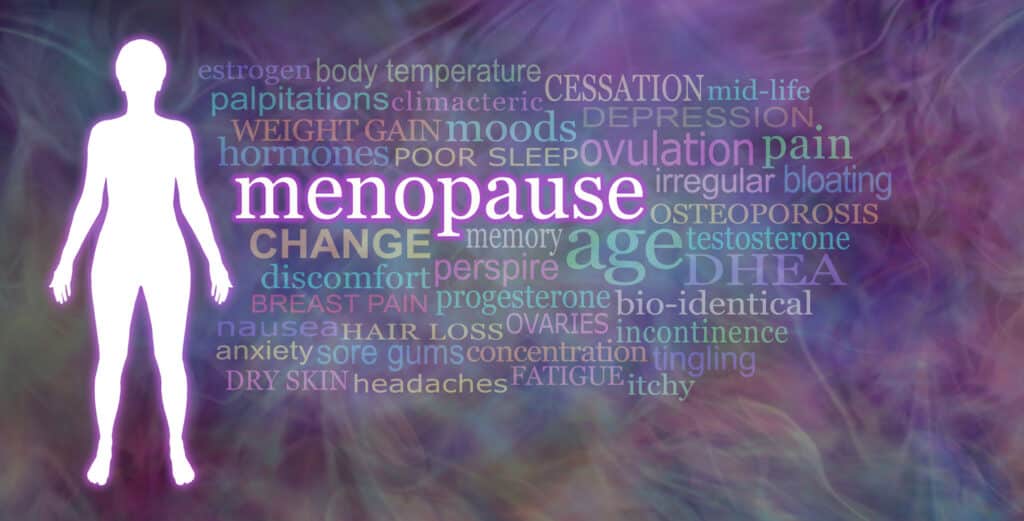Low progesterone is one of the most common hormonal imbalances in perimenopause.
Progesterone plays a crucial role in regulating the menstrual cycle and maintaining overall hormonal balance.
It is considered the “sister hormone” to estrogen and therefore is critical for estrogen balance.
It also is usually the FIRST hormone to start to cause perimenopause symptoms in women over 35.
In order to have an easy time of perimenopause estrogen and progesterone must be in balance with each other.
Many women don’t realize that what they think of as perimenopause symptoms is actually low progesterone allowing estrogen to get out of whack.
In most women in their late 30s progesterone begins to decline.
And since estrogen doesn’t always decline at the same time, estrogen is unchecked by its sister hormone, progesterone.
This leads to many symptoms of what is called “estrogen dominance”.
Estrogen dominance doesn’t necessarily mean your estrogen is high.
In fact, your estrogen could still be low as you are experiencing estrogen dominance!
So, it is essential that you recognize the signs of low progesterone in order to minimize overall perimenopause symptoms.

And it is possible to go through perimenopause with minimal disruption as long as you pay attention to your signs and symptoms and adjust your treatments accordingly.
Here we will explore the ten signs of low progesterone in perimenopausal women and shed light on this common hormonal imbalance.
- Irregular Menstrual Cycles
One of the hallmark signs of low progesterone is irregular menstrual cycles. You may experience unpredictable periods, characterized by shorter or longer cycles, missed periods, or spotting between periods. These irregularities occur due to insufficient progesterone levels needed to maintain a regular cycle.
- Heavy or Painful Periods
Low progesterone can contribute to heavier and more painful periods. Progesterone helps balance the effects of estrogen, preventing excessive buildup of the uterine lining. Without adequate progesterone, the lining may become thicker, resulting in heavier bleeding and more intense menstrual cramps.
- Mood Swings and Anxiety
Progesterone plays a vital role in regulating mood and promoting a sense of calmness. When levels are low, perimenopausal women may experience mood swings, increased anxiety, irritability, and even depression. These emotional changes can significantly impact daily life and interpersonal relationships.
- Sleep Disturbances
Progesterone promotes restful sleep by exerting a sedative effect on the brain. Low levels of progesterone during perimenopause can lead to insomnia, disrupted sleep patterns, and difficulty staying asleep throughout the night. Consequently, fatigue and daytime sleepiness may become common complaints.
- Hot Flashes and Night Sweats
While often associated with estrogen fluctuations, low progesterone can also contribute to hot flashes and night sweats. Progesterone helps regulate body temperature, and its deficiency can trigger sudden episodes of intense heat and sweating, often followed by chills.
- Vaginal Dryness and Painful Intercourse
Progesterone aids in maintaining vaginal lubrication and elasticity. When levels decline, vaginal dryness can occur, leading to discomfort, itching, and pain during sexual intercourse. These symptoms can affect a woman’s sexual satisfaction and quality of life.
- Decreased Libido
Low progesterone levels may contribute to a decline in sexual desire or libido. Progesterone influences the production of testosterone, an important hormone for sexual arousal. Therefore, a decrease in progesterone can indirectly affect a woman’s sexual drive.
- Weight Fluctuations
Progesterone influences metabolism and helps regulate weight. When progesterone levels are low, it can contribute to weight gain, especially around the abdominal area. This hormonal imbalance can make it challenging for perimenopausal women to maintain a healthy weight.
- Memory Problems and Brain Fog
Progesterone receptors are present in various areas of the brain, and this hormone has been shown to affect cognitive function. Low progesterone levels can result in memory problems, difficulty concentrating, and “brain fog” – a feeling of mental confusion or haziness.
- Breast Tenderness
Progesterone works in tandem with estrogen to regulate breast tissue growth. When progesterone levels are insufficient, estrogen dominance can occur, leading to breast tenderness, swelling, and discomfort. Women may notice increased sensitivity and lumpiness in their breasts.

What can you do to manage progesterone levels during perimenopause?
As I mentioned earlier, progesterone must be abundant in order to reduce perimenopause symptoms.
Of course, you can always ask your doctor to test your levels and you may want to consider bio-identical hormone replacement therapy (BHRT).
But no pill is going to make up for imbalances in your health.
So always make sure you are focusing on your food and lifestyle approach as well.

The following are some key ways to manage progesterone levels during perimenopause:
- Balanced Diet
Eating a well-balanced diet is essential for overall health and hormonal balance.
Include foods rich in specific nutrients that support progesterone production, such as vitamin C, vitamin B6, magnesium, and zinc. Incorporate plenty of whole foods like leafy greens, citrus fruits, nuts, seeds, whole grains, eggs, and lean proteins into your meals to support optimal hormone production.
- Manage Stress Levels
Chronic stress can negatively impact hormone production and balance. Practice stress management techniques like meditation, deep breathing exercises, yoga, or engaging in hobbies and activities you enjoy.
Adequate sleep, regular exercise, and setting aside time for self-care can also help reduce stress levels and support hormonal balance.
Spending time in nature and helping others have also been shown to be powerful tools for reducing cortisol (“the stress hormone”) in the body.
- Natural Supplements
Certain natural supplements can assist in managing progesterone levels. Consult with a healthcare professional or a naturopathic doctor to determine the most suitable supplements for your specific needs.
One of the most effective supplements you can use is chaste berry (Vitex). A dose of 800-1,000 mg/day taken throughout the day has been shown to significantly increase the natural production of progesterone in women.
This particular supplement has been a “lifestyle-saver” for me throughout my 40s and into my 50s.
I highly recommend checking it out. But please do not start any supplement without first consulting with your healthcare provider (ideally a nutritionist who understands perimenopause treatments).
If you are going through perimenopause or you have recently transitioned into post-menopause and you want support, we have a program designed just for that.
We will guide you through the process of how to optimize your lifestyle through nutrition, physical activity, stress management, sleep, and mindset.
These are the foundational factors to focus on while you are balancing your hormones and striving for excellent health.
Click the link below to find out about our “Sail Through Perimenopause” program.
